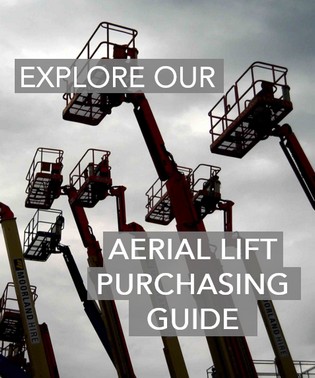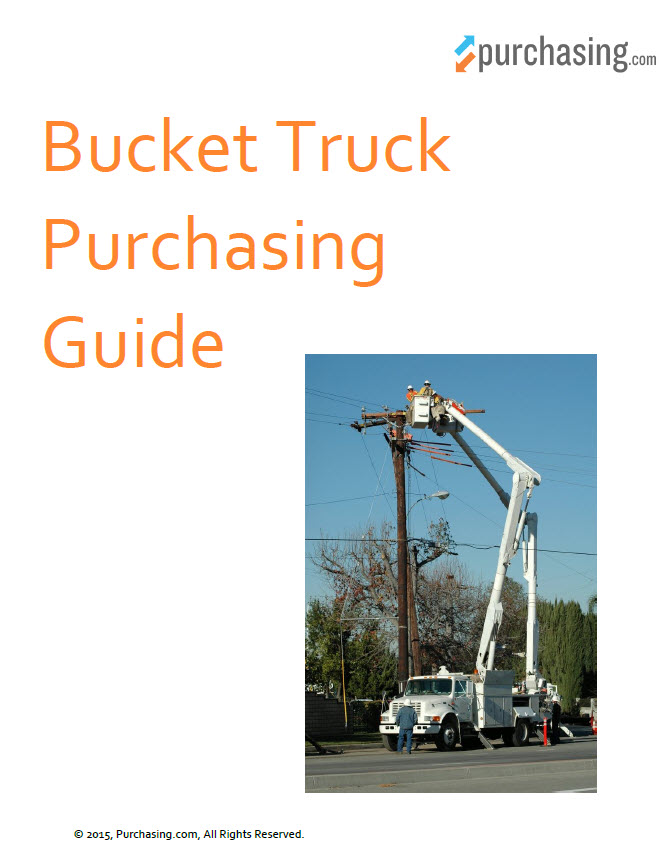Introduction to the Bucket Truck Buying Process
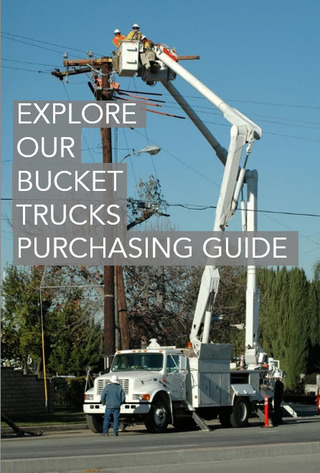 Table of Contents
Table of Contents
- Introduction
- Trends
- Types
- Specs
- Accessories
- Choosing a Dealer
Introduction
Bucket trucks have become one of the primary vehicles for industries like telecom and forestry as well as local utility companies and construction firms. They enable workers to safely reach heights of up to 125 feet while allowing the repositioning of the bucket to reach out-of-the-way spots that would be impossible or unsafe to attempt with a ladder or scissor lift.
Classified as boom trucks by OSHA, bucket trucks offer a broad level of maneuverability that makes them ideally suited to applications including:
- Sign maintenance
- Line servicing for telecom and utilities
- Tree care
- Landscaping
But since they incorporate a vehicle-mounted aerial device to lift people, tools, and materials to height, they also require certification in certain states including California, Washington, Utah, and Minnesota.
Purchase considerations
Cost tends to be primarily impacted by the type of truck selected and the height of the platform. Expect to pay $37,000 to $140,000 for a standard light-duty bucket truck that's used for routine facilities maintenance, utility service, or something similar. Heavy-duty trucks used for construction, forestry, and a range of other tasks at elevated heights run between $84,000 and $370,000.
In general, there are two aspects to keep in mind as you begin to compare models. It's worth noting that one will directly affect the other. These include:
- Type of work performed: When considering frequent tasks and jobsites, factor in the total weight you need the bucket truck to accommodate, the necessity of side-reach functionality (if common work areas are removed from access roads), and whether material handling capabilities are a necessity.
- Body type: The body type you select will be determined by your intended use. Service bodies typically come in steel, aluminum, and fiberglass and offer a combination of fuel efficiency, durability, storage, and style (an important factor as many vehicles double as a company truck or mobile office on the road).
This purchasing guide walks you through the buying process for a new or used bucket truck. We cover the types, specs, and accessories that have the greatest impact on your purchase decision as well as what you can expect to pay for each type. We'll also take a look at the certification deadline, which states currently require certification for the operation of a bucket truck, and where you can find certification training for yourself or your employees.
Trends
The functionalities and specs of a bucket truck, in addition to cost, are often weighed against competing types of machinery to determine which is capable of providing the highest level of performance. Taken together, these considerations lead to two questions that are affecting the sale of bucket trucks throughout the United States:
- Aerial lift or bucket truck?
- New or used?
We discuss these questions in more depth below.
Aerial lifts vs. bucket trucks
On first glance, the bucket end of an aerial lift almost mirrors that of a bucket truck. Yet while the two types of machinery may offer access to heights, they serve very different functions.
Aerial lifts are actually comprised of three different types of personnel lifts:
- Boom lifts (the type that closest resembles a bucket truck)
- Scissor lifts
- Standard personnel lifts
Each of these three designs will lift one or more operators to height. But, in the case of scissor lifts and personnel lifts, many are only designed for smoothly paved and level surfaces and accommodate a limited amount of weight and personnel.
Boom lifts offer more versatility, often incorporating heavy-duty tires that give access to a much wider range of locations. But they're somewhat limited in the platform weights they can support, lifting up to 500 lbs on average. Operated almost entirely by controls mounted in the bucket, this type of machine will also require transport to and from the jobsite as the engine provides minimal speed and is not capable of travel over long distances.
The one advantage a boom lift has over a bucket truck is maneuverability. With small, compact bodies, they are often capable of sidling right up next to a building. Many can also swing their boom in a 360-degree arc, allowing the operator to access any space within the machine's operating radius without moving the body of the lift.
- Purchasing tip: If your work environment involves costly or fragile grounds (like a golf course or sports field), or if you're limited by tight, restrictive spaces that do not provide access to a full-size truck, a boom lift may actually work better for you than a bucket truck.
In contrast, bucket trucks provide many of the same basic functions, though at lesser elevations and with a greater overall weight, as the lift itself is mounted onto the back of a full-size service truck. Similar to many aerial lifts, they provide extended access through the continuous and unrestricted rotation of the boom. However, given the weight of the truck beneath them, many bucket lifts are able to heft more weight fully extended, with 400 to 2,000 lbs serving as a common range for max platform capacity.
- Purchasing tip: If you need material handling capabilities or routinely lift heavy items to height, the added stability of a bucket truck will probably provide safer, more cost effective operation.
New vs. used
This is a common question among buyers for every type and size of heavy equipment. When it comes to bucket trucks, there are three main things to consider:
- Warranty. Like any vehicle, a new bucket truck comes backed by a manufacturer's warranty covering faulty parts or workmanship. Though the warranty may be transferable from one party to the next, many used models are between 3 to 5 years old. In these cases, warranties have long since expired. If you need the assurance of a warranty, possibly in the hope of avoiding any repairs right away, a used bucket truck is probably not for you.
- Condition. More so than either of the other two considerations, the condition of the truck is a key element that can help determine the cost-effectiveness of a used purchase. Unlike other machines, you're actually considering the condition of two pieces of equipment: the lift and the truck it's mounted to.
Most problems with new equipment reportedly occur within a few months of purchase and at low mileage. When considering a used bucket truck, this works to your advantage as all the kinks have been worked out and (hopefully) repaired. Look for maintenance and service records to ensure all recommended and required intervals were adhered to - vehicles that were part of a company fleet often fit that bill. - Cost. This should never be the most important consideration as a "good deal" can end up costing you far more than a new model in repairs. But in general, a good used bucket truck with low mileage and a verifiable service record can save you 50% or more when compared to a new model. Ideal for individuals and small businesses, used bucket trucks purchased through a qualified dealer may also provide a service package that could help minimize costs associated with service and repairs.
Types
From billboards and storefronts to woodland areas and other remote locations, one of the most important determining factors when comparing bucket truck types is the work environment you expect the machine to operate in. Of particular importance are height and articulation.
For example, if your jobsite has a height requirement of 40 feet, you'll need a bucket truck that offers at least that or slightly above. But if that same jobsite also has hard to reach locations such as work areas inset from buildings or those situated away from paved or reasonably level surfaces (commonly found on construction 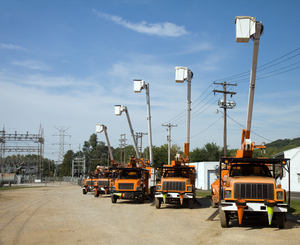 sites), you'll need to compensate. This is achieved by purchasing a machine with greater height capacity and articulated non-overcenter capabilities, providing enhanced access through continuous rotation.
sites), you'll need to compensate. This is achieved by purchasing a machine with greater height capacity and articulated non-overcenter capabilities, providing enhanced access through continuous rotation.
With your average work environment in mind, compare the following four types:
- Articulated overcenter lift
- Articulated non-overcenter lift
- Telescopic articulated bucket truck
- Insulated bucket truck
Articulated overcenter lift
Typically ranging in height capacity from 35 to 55 feet, articulated overcenter lifts allow the operator to access hard-to-reach spots through a boom that travels over the center of the truck. With max horizontal overcenter heights that cap out around 50 feet and horizontal reach capabilities that extend to nearly 30 feet, overcenter lifts are common among forestry, construction, landscaping, and those that operate in similarly rugged terrain.
- Expect to pay around $50,000 for the chassis cab alone and between $100,000 and $250,000 for the vehicle and lift.
Articulated non-overcenter lift
In contrast, articulated non-overcenter lifts feature a design that holds the upper boom at a steady angle as the bucket is raised or lowered. This prevents the bucket from crossing over the center of the truck and makes articulated non-overcenter aerials largely suited to easily accessed locations that do not require jockeying or repositioning during service.
Non-overcenter models are geared primarily to fixed locations with easy access, including building maintenance and select telecom or utility services. Common articulation specs average 70 degrees above horizontal and a total of 175 degrees in relation to the lower boom.
- Expect to pay between $45,000 and $120,000 for new to recently manufactured models.
Telescopic articulated bucket truck
Offering the maneuverability of an overcenter aerial, telescopic articulated bucket trucks tack on extra reach, providing access from 61 to 70 feet in the air. Designed for sign and lighting maintenance, their heavy-duty chassis, extra outriggers, and robust jib capacities (that accommodate payloads up to 2,000 lbs) also enable them to be used for a variety of forestry and construction applications.
- Expect to pay $70,000 to $150,000 for new and recently manufactured models.
Insulated bucket truck
Insulated bucket trucks are designed primarily for utilities crews and those working around electrical cabling. They're constructed of dielectric components such as fiberglass, preventing the conduction of electricity.
Two specific components comprise an insulated truck: the basket and the boom. The boom has two insulated gaps, one in the boom's elbow and one between the mount and the chassis. Often available as overcenter, non-overcenter, and telescopic, an insulated bucket truck can provide the same levels of height and articulation as non-insulated models.
The difference is in the price. Due to the fiberglass components used in the service body, expect to pay a minimum of $90,000 to $100,000 and as much as $230,000 for new or recently manufactured models.
For more information, compare bucket truck models for top brands Versalift, Utility Fleet and more.
Back to top
Specs
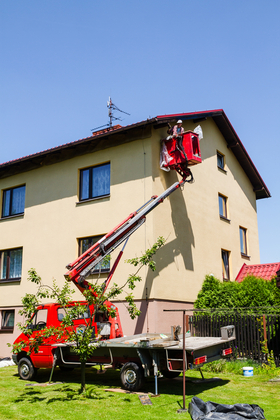 In addition to body type, one of the most common means of differentiating between bucket truck models is by comparing the technology, power, and performance available through their individual specs. With that in mind, here's a brief rundown on some of the aspects that usually factor into a purchase decision:
In addition to body type, one of the most common means of differentiating between bucket truck models is by comparing the technology, power, and performance available through their individual specs. With that in mind, here's a brief rundown on some of the aspects that usually factor into a purchase decision:
Platform height
While many manufacturers offer a basic range of bucket trucks that provide similar platform heights (40 feet seems to be highly common within this niche), some brands specialize in heights on either end of the extreme as well. This enables us to divide bucket trucks into three different categories by platform height:
- 29 to 45 feet, often including non-overcenter models
- 45 to 65 feet, often including overcenter models
- 65 to 125 feet, often including overcenter and telescopic models
Side reach
Bucket trucks are known as articulated aerials for their ability to reach out from the center of the truck, lifting bucket and worker or in some cases materials. But exactly how far they reach varies from truck to truck.
Depending on the model selected, most trucks offer between 30 to 51 feet of side reach, largely based on the intended functionality of the machine. Heavy-duty bucket trucks, like those designed for materials handling, provide the farthest reach in relation to their platform height. It is common to find a unit with a platform height of 42 or 57 feet with a side reach of 30 or 37 feet respectively. Telescopic models seem to offer the least amount of reach in comparison to their platform height, with 87 feet for height and 47 feet of reach serving as one example.
Chassis
The chassis is the truck component of a bucket truck. Manufactured by Mercedes-Benz and Dodge, it's also highly common to find chassis manufactured by Ford. The chassis factors into your purchase decision by limiting the total amount of weight on the axle.
Depending on the model you select, the bucket truck may be capable of a max gross axle weight rating (GAWR) from 6,000 to 7,000 lbs on the front axle and 6,700 to 14,700 lbs on the rear. Heavy-duty models like those intended for materials handling or telescopic operation may allow up to 20,000 lbs on the front axle and 34,000 lbs on the rear.
Weight capacity
The GAWRs listed above can be deceiving as they encompass the entire weight of the boom, bucket, operator, materials, and the vehicle itself. In general, most bucket trucks have a platform capacity between 400 and 2,000 lbs. Models that provide higher elevation or greater degrees of side reach offer less in terms of platform weight capacity. And the more weight they heft, the more you can expect to pay.
Fuel type
Bucket trucks are typically powered by a diesel engine, offering horsepower from 200 @ 2300 RPM to 385 @ 5500 RPM. Where you'll find an exception is among newer models like the Altec Green Fleet. Incorporating hybrid technology into their power system, these new hybrid bucket trucks combine a diesel engine with an electric motor. The diesel is used to drive the vehicle and the electric motor powers aerial functions, with the diesel engine picking up any slack should the battery wear out before the job is complete.
In addition to fuel efficiency, this design reportedly provides quieter operation for aerial tasks while cutting emissions, according to the manufacturer. It also has the potential to reduce maintenance since an electric engine is built with fewer moving parts than its diesel counterpart.
Transmission
Another way of referring to the driveline or drivetrain of the vehicle, you'll find both automatic and manual transmissions available for bucket trucks. Common examples include the Ford F750 mentioned above which is automatic and the International 4300 which offers manual transmission.
In terms of cost-savings through operation, they're both about the same. Therefore type selection is typically motivated by operator preference. Generally speaking, older operators tend toward manual transmissions while younger operators lean toward automatic. That being said, they're not without their differences. Though a manual transmission offers more control overall, an automatic transmission provides a smoother ride with less roll-back on inclines. They also tend to be more expensive than a manual transmission, adding $1,000 to $3,000 or more onto the price tag.
Back to top
Accessories
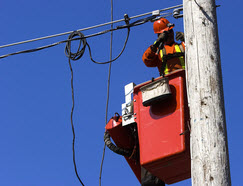 Bucket truck accessories tend to be divided into categories based on their intended use. Three of the most popular of these categories include telecom, forestry and general use/utilities. The following accessories are the most popular within each industry.
Bucket truck accessories tend to be divided into categories based on their intended use. Three of the most popular of these categories include telecom, forestry and general use/utilities. The following accessories are the most popular within each industry.
Telecom
- Wire dispenser: Popular among arborists and linemen alike, a wire dispenser meters out a wide variety of cable while preventing it from becoming tangled. Featuring quick, simple operation, just pull up on the pivot swing arm, load the cable, and secure the arm back in place with a bolt and wing nut. Expect to pay: $120.
- Hotline jumper holder: Used by utilities workers, construction crews, and occasionally among telecom service personnel, a hotline jumper holder frees up a worker's hands by securing the hotline to the bucket. Crafted from non-conductive fiberglass material, it's compatible with insulated or non-insulated bucket trucks. Expect to pay $225.
- Air compressor: Serving as the power source for a variety of air tools, an air compressor is usually a separate towable unit that offers 175 to 195 CFM on average. Most are diesel powered and feature a straightforward control panel, allowing a single unit to power a number of different tools within any environment. Expect to pay $5,000 for models within this range.
- Bucket step: Optional bucket steps simplify entry and exit of the bucket and dramatically increase safety and comfort. Manufactured from fiberglass material, they feature anti-skid pads that prevent slipping in wet or icy weather. They also come in two different varieties, depending on whether the bucket has a liner, and offer 1 to 2 steps. Expect to pay: $180 to $430.
Forestry
- Chainsaw boom: As popular among arborists and landscapers as they are with forestry personnel, a chainsaw boom is a fiberglass extension with a saw attached to the end. Providing up to 62 inches of additional reach, many models can cut branches up to 13 inches in diameter and weigh less than 9 lbs. Safety features include a two-step trigger with trigger guard, to avoid accidentally engaging the saw, and a sprocket cover that prevents injury to fingers and bodily limbs. Expect to pay: $1,300 to $2,000.
- Chainsaw scabbards: Offering a safe place to securely and conveniently store a chainsaw within reach of the bucket, chainsaw scabbards are made from non-conductive fiberglass. Pocket depths average 18 inches with an overall length for the entire scabbard of around 32 inches. Heavy-duty models also include an extra layer of high-density plastic in the saw pocket to provide long-lasting wear. Plus, many are designed with a removable liner that can be easily replaced once it begins to wear through. Expect to pay: $175 to $270.
- Boom strap: One of the most common types of fall protection equipment available, boom straps secure a bucket truck operator to the side of the boom to prevent falls. Most are crafted from heavy-duty nylon webbing that's up to 2 inches thick with a sliding D-ring that connects the system to the boom. Expect to pay: $90 to $100.
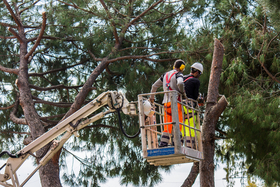
General use / utilities
- Bucket cover: Designed to prevent debris, rain, snow, and other elements from getting into the bucket when not in use, a bucket cover is secured tight to the rim of the bucket with an elastic cord to ensure it stays securely in place during transport. Crafted from heavy-duty reinforced vinyl, many also include a grommet and shock cord to accommodate a tie line. It's worth noting that most are cut to cover the bucket opening only and do not encompass the upper control unit. Expect to pay: $85 to $110.
- Tool box: Depending on the size of your bucket and the duration of the job, there are a couple different types of tool boxes to accommodate the necessary range of tools. The first is actually not a box but a canvas bucket, featuring an oval opening for the storage of large items as well as more than a dozen outside pockets (available on deluxe models) for quick access to smaller tools. The second variety is more of a traditional box, measuring 8 to 17 inches wide and crafted from polyethylene. This version commonly features a slightly tipped design to prevent tools from falling out. Expect to pay $80 to $100 for a canvas bucket and $100 to $140 for the traditional box variety.
- Ground protection mat: As is often the case on a range of different jobsites, terrain can become difficult to navigate when it gets wet and trucks continuously drive the same path. To combat slipping and sliding, not to mention getting stuck, ground protection mats provide an interlocking path that can withstand up to 120 tons. Designed to bend without breaking, they're made from polyethylene and are easy cleaned with any standard hose. Expect to pay: $160 to $250 for a section measuring 4' x 8'.
- Wheel chock: Blocking the bucket truck in place, wheel chocks are made of heavy-duty molded rubber with a grip design on the underside to prevent sliding on loose or muddy terrain. Many models also come with a built-in eyebolt that allows you to link two or more chocks together or run a chain through them to prevent theft. Expect to pay: $15 to $40 each.
Choosing a Dealer
While the above types, specs, and accessories affect the bucket trucks you'll compare, the dealer you select is just as important. In fact, quality dealer support is often viewed as one of the most essential aspects of a bucket truck purchase. Shown to cut costs associated with maintenance and repair while extending the life of the truck itself, dealers offer a range of post-sale services each of which has the potential to serve your bottom line.
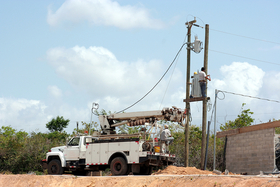 Bucket trucks aren't as widely manufactured as other types of aerial lift equipment. But those that do offer them typically have long-standing reputations that are often the result of brand consolidation. Leading manufacturers include Terex, Versalift, Altec, and Armlift, among others.
Bucket trucks aren't as widely manufactured as other types of aerial lift equipment. But those that do offer them typically have long-standing reputations that are often the result of brand consolidation. Leading manufacturers include Terex, Versalift, Altec, and Armlift, among others.
Here are some of the most critical aspects of dealer support and what to be on the lookout for as you begin to compare dealers in your area.
Maintenance/repairs
Often viewed as one of the most valuable aspects of dealer support, a maintenance or service level agreement (SLA) will define the level and frequency of your service plan. The best SLAs define every aspect of support - from service intervals to the cost of each part or aspect of labor associated with maintenance.
The SLA also provides an easy way to compare dealers side by side. In particular, pay attention to:
- Maintenance and inspections: What do they include? Common aspects may cover dielectric testing, aerial lift/boom inspection, leveling system, and hydraulic cylinder.
- Service hours: 24/7 is the gold standard; if not, what is their response time after a weekend or holiday?
- Service bays: If they do not provide on-site service, how many bays does their facility provide? Anywhere between 40 and 50 bays indicates a large operation.
- Service facilities: Do they have one in your area?
- Technicians: How many mobile technicians do they have on staff and what is their average response time?
Get Quotes
- We contact sellers
- They compete for your business
Training resources
Operator training is another area where a dealer can save you a lot of money by supplementing your standard employee training program. Aspects covered are usually region-specific and typically include operation, maintenance, and safety. Leading manufacturers - and Terex in particular - offer service seminars throughout the year that address the different components of a bucket truck with customized training available depending on the particular needs of your company.
Check with the dealer you're considering to find out whether they sponsor local training or if there are additional resources available. Because unlike other types of heavy equipment, bucket trucks do require certification and specialized licensing.
Operator requirements
Bucket trucks with a gross vehicle weight rating (GVWR) over 26,000 lbs require a commercial driver's license. This limitation is easily surpassed by most mid-range to large-scale bucket trucks. In addition, the Occupational Safety and Health Administration is requiring the certification of all crane operators by 2017. It's worth noting that some states already require operators to be certified by the National Commission for the Certification of Crane Operators (NCCCO).
While your dealer will be able to advise you on the exact regulations affecting your locale, here's an informal summary of state by state requirements as well as the specific federal rules that mandate crane operation (and bucket trucks by extension).
